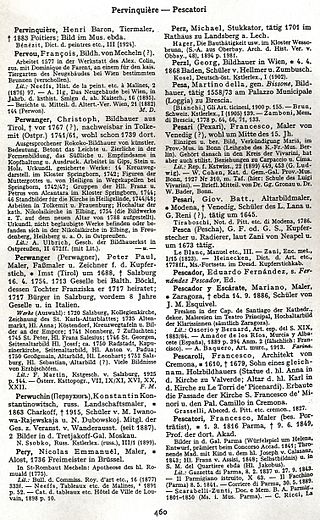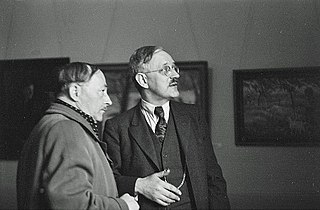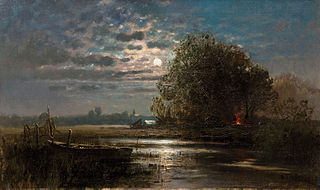
Hans Vollmer (16 November 1878 – 15 February 1969) was a German art historian and encyclopedist.

Hans Vollmer (16 November 1878 – 15 February 1969) was a German art historian and encyclopedist.
His father was the architect Johannes Vollmer (1845-1920), his grandfather the Hamburg marine painter and graphic artist Adolph Friedrich Vollmer (1806–1875). He was the older brother of the painter and sculptor Erwin Vollmer (1884–1973).
Vollmer studied art history, history and philosophy in Berlin and Munich. In 1906 he was awarded a doctorate under Heinrich Wölfflin in Berlin with a thesis on Schwäbische Monumentalbrunnen von der Gotik bis zum Klassizismus (Swabian monumental fountains from the Gothic to Classicism).
Since April 1, 1907 he was employed in the editorial office of the Thieme-Becker Allgemeiner Künstlerlexikon at the publishing house E. A. Seemann in Leipzig; in 1923 he took over the editorial management of the Encyclopedia. Since then he was the main contributor, supported by a small editorial staff, until the completion of the 37-volume work in 1950, after which he began working on the additions for the 20th century. The General Encyclopedia of Visual Artists of the XXth Century appeared in six volumes from 1953 to 1962. He dictated a total of 47,229 artist biographies to his secretary Claire Möbius, who also worked as a research assistant, on the basis of notes which he excerpted predominately in the Deutsche Bücherei in Leipzig; 15 to 20 typewritten pages were produced daily. In 1952 he was appointed professor. In recognition of his work Vollmer received the Patriotic Order of Merit in silver of the German Democratic Republic in 1957. [1]
On 1 January 1964 Vollmer retired after 57 years of work for the Künstlerlexikon. He died in Leipzig at age 90.

Adolph Friedrich Vollmer was a German landscape and marine painter and graphic artist. He and his contemporary, the painter Christian Morgenstern, were pioneers in Hamburg of early Realism in painting.

Christian Ernst Bernhard Morgenstern was a German landscape painter. Morgenstern is regarded as one of the pioneers in Germany of early Realism in painting. He gained this reputation in Hamburg 1826-1829 together with his contemporary Adolph Friedrich Vollmer while both were still studying; from 1830 onwards, Morgenstern, together with Friedrich Wasmann, Johan Christian Dahl and Adolph Menzel, introduced Munich to Realist painting.

Thieme-Becker is a German biographical dictionary of artists.

Oskar Frenzel was a German landscape-artist, animal painter and lithographer.

Anna Klein was a German landscape, animal and genre painter. She specialized in motifs from Upper Bavaria and Tyrol and designed many utilitarian items such as labels, bookplates and postcards in addition to her canvases. A large number of her paintings may be found at the Gemäldegalerie Dachau, where a retrospective was held in 2008.

Ulrich Thieme was a German art historian. He was the son of the industrialist and art collector Alfred Thieme (1830–1906), brother of the publisher Georg Thieme (1830–1906) and grandfather of the painter Peter Flinsch (1920–2010).
Erwin Lang was an Austrian painter. His work was part of the painting event in the art competition at the 1928 Summer Olympics.
Johann Baptist Heinefetter was a German Romantic painter.

Heinrich Hermanns was a German lithographer and landscape painter. He was also known for architectural paintings and vedute and was associated with the Düsseldorfer Malerschule.
Franz Heckendorf was a German expressionist painter closely associated with the Berlin Secession. He contributed works to the painting event in the art competition at the 1928 Summer Olympics. His work was highly regarded during the Weimar Republic but from 1937 was classed as entartete Kunst. During World War II, he was incarcerated in various prisons and eventually in Mauthausen concentration camp for helping Jews escape over the Swiss border.
Günter Meißner was a German art historian, who became known as editor-in-chief and publisher of the Allgemeines Künstlerlexikon.

Max Schwimmer was a German painter, graphic artist and illustrator.
The Master of the Prenzlauer Hochaltars is the notational name of one or rather two artists working in Lübeck at the beginning of the 16th century, named after the high altar of the Marienkirche in Prenzlau, dated 1512.

August Brömse was a Bohemian German etcher and painter.
Franz Stassen was a German painter and illustrator.
Robert Friedrich Karl Scholtz was a German expressionist portrait and landscape painter, graphic artist and draughtsman. He belonged to the Berlin Secession mouvement.

Friedrich Wilhelm Theodor Heyser was a German portrait, landscape, and history painter.

Otto Karl Heinrich Fritz Fedder was a German landscape painter.

Paula Freiin von Wächter-Spittler was a German painter.
Gertrud Bürgers-Laurenz was a German flower and portrait painter.